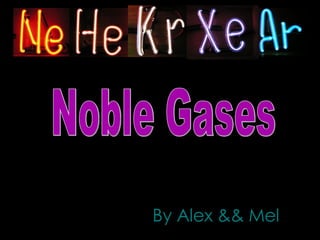Noble Gases
•Transferir como PPT, PDF•
6 gostaram•9,531 visualizações
This gives a brief overview of the noble gases. (includes animations on 2nd slide)
Denunciar
Compartilhar
Denunciar
Compartilhar

Recomendados
Recomendados
Mais conteúdo relacionado
Mais procurados
Mais procurados (20)
Classification of elements and periodicity in properties

Classification of elements and periodicity in properties
Destaque
Destaque (20)
Spectrophotometry: basic concepts, instrumentation and application

Spectrophotometry: basic concepts, instrumentation and application
Semelhante a Noble Gases
Semelhante a Noble Gases (20)
Flame Photometry, by Dr. Umesh Kumar Sharma & Shyma M. S.

Flame Photometry, by Dr. Umesh Kumar Sharma & Shyma M. S.
Mais de Alex Davies (9)
Último
God is a creative God Gen 1:1. All that He created was “good”, could also be translated “beautiful”. God created man in His own image Gen 1:27. Maths helps us discover the beauty that God has created in His world and, in turn, create beautiful designs to serve and enrich the lives of others.
Explore beautiful and ugly buildings. Mathematics helps us create beautiful d...

Explore beautiful and ugly buildings. Mathematics helps us create beautiful d...christianmathematics
Último (20)
ICT Role in 21st Century Education & its Challenges.pptx

ICT Role in 21st Century Education & its Challenges.pptx
Web & Social Media Analytics Previous Year Question Paper.pdf

Web & Social Media Analytics Previous Year Question Paper.pdf
Explore beautiful and ugly buildings. Mathematics helps us create beautiful d...

Explore beautiful and ugly buildings. Mathematics helps us create beautiful d...
Presentation by Andreas Schleicher Tackling the School Absenteeism Crisis 30 ...

Presentation by Andreas Schleicher Tackling the School Absenteeism Crisis 30 ...
Basic Civil Engineering first year Notes- Chapter 4 Building.pptx

Basic Civil Engineering first year Notes- Chapter 4 Building.pptx
Unit-IV; Professional Sales Representative (PSR).pptx

Unit-IV; Professional Sales Representative (PSR).pptx
Noble Gases
- 1. By Alex && Mel Noble Gases
- 4. Atomic Number: 2 Melting Point: -272.0 °C (1.15 K, -457.6 °F) Boiling Point: -268.6 °C (4.549994 K, -451.48 °F) Number of Protons/Electrons: 2 Number of Neutrons: 2 Density @ 293 K: 0.1785 g/cm 3 Date of Discovery: 1895 Discoverer: Sir William Ramsay Name Origin: From the Greek word hêlios (sun) Uses: balloons, deep sea diving Obtained From: natural gas deposit, air The dangers of inahing helium are rare, but if you don't breathe for 5 seconds in between, you could get a soar throat or maybe pass out. Can't be made into compounds
- 5. Atomic Number: 10 Atomic Mass: 20.1797 amu Melting Point: -248.6 °C (24.549994 K, -415.48 °F) Boiling Point: -246.1 °C (27.049994 K, -410.98 °F) Number of Protons/Electrons: 10 Number of Neutrons: 10 Density @ 293 K: 0.901 g/cm 3 Date of Discovery: 1898 Discoverer: Sir William Ramsay Name Origin: Form the Greek word neos (new) Uses: lighting Obtained From: liquid air The danger is Asphyxiation but that is very rare. Can't be made into compounds.
- 6. Atomic Number: 18 Atomic Mass: 39.948 amu Melting Point: -189.3 °C (83.85 K, -308.74 °F) Boiling Point: -186.0 °C (87.15 K, -302.8 °F) Number of Protons/Electrons: 18 Number of Neutrons: 22 Density @ 293 K: 1.784 g/cm 3 Date of Discovery: 1894 Discoverer: Sir William Ramsay Name Origin: From the Greek word argon (inactive) Uses: Lighting Obtained From: air Argon has the opposite effect as helium on your voice. Because it is so dense - it makes your voice lower. Which means it has the same dangers as helium. Can't be made into compounds.
- 7. Krypton is not toxic, but in an enclosed environment, it can displace air and cause asphyxiation. Can't be made into compounds. Atomic Number: 36 Atomic Mass: 83.8 amu Melting Point: -157.2 °C (115.950005 K, -250.95999 °F) Boiling Point: -153.4 °C (119.75001 K, -244.12 °F) Number of Protons/Electrons: 36 Number of Neutrons: 48 Density @ 293 K: 3.74 g/cm 3 Date of Discovery: 1898 Discoverer: Sir William Ramsay Name Origin: From the Greek word kryptos (hidden) Uses: Lighting Obtained From: production of liquid air
- 8. The xenon lights in cars hurt peoples eyes which can be dangerous but they aren't harmful. In 1962 the first noble gas compound was produced by Neil Bartlett, combining xenon, platinum and fluorine. It is now possible to produce xenon compounds in which the oxidation states range from +2 to +8(!). Atomic Number: 54 Atomic Mass: 131.29 amu Melting Point: -111.9 °C (161.25 K, -169.42 °F) Boiling Point: -108.1 °C (165.05 K, -162.58 °F) Number of Protons/Electrons: 54 Number of Neutrons: 77 Density @ 293 K: 5.8971 g/cm 3 Date of Discovery: 1898 Discoverer: Sir William Ramsay Name Origin: From the Greek word xenon (stranger) Uses: powerful lamps, bubble chambers Obtained From: liquid air
- 9. Atomic Number: 86 Atomic Mass: (222.0) amu Melting Point: -71.0 °C (202.15 K, -95.8 °F) Boiling Point: -61.8 °C (211.35 K, -79.24 °F) Number of Protons/Electrons: 86 Number of Neutrons: 136 Density @ 293 K: 9.73 g/cm 3 It is radioactive and is naturally formed like oxygen which means it is everywhere it is around wherever air is allowed to stagnate. Can't be made into compounds. Date of Discovery: 1898 Discoverer: Fredrich Ernst Dorn Name Origin: From radium Uses: treatment of cancer Obtained From: decay of radium
- 10. By Mel & Alex :] :]
